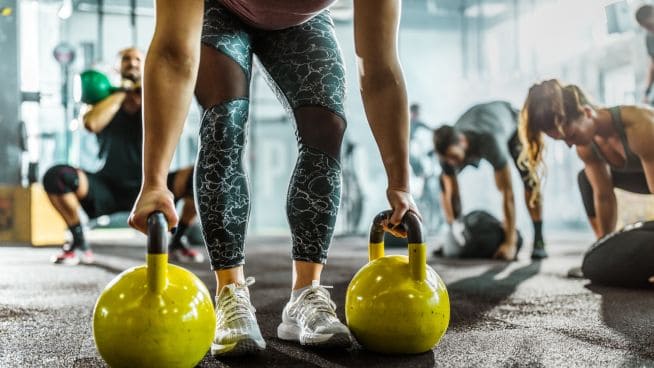I’m Barely Eating But My Body Isn’t Changing. Why?
Tells me if this sounds familiar…
You are a female athlete.
You train hard, and do so 5-6 days a week.
You want to be in your BEST shape for the upcoming season.
But your weight and body composition just aren’t changing.
One week, between training, school and work—you just don’t have much time to eat. The scale moves down a little. It feels good to see something happen. So you start eating a little less. After all, it saves time, and it looks like you’re going in the right direction.
But then the progress stops again.
During your training, you feel fatigued. You keep pushing harder, but your body composition won’t budge. You feel defeated. With your season right around the corner, you’re already stressing out.
You think to yourself…“How could I work so hard and not get results?”
The unfortunate truth is it happens ALL THE TIME—to casual gym-goers and pro athletes alike! For athletes, whose body composition is often closely related to their performance, it can be a vicious cycle.
If an athlete doesn’t see the results she is looking for right away, she might try to “DO MORE,” which often equates to:
- Training HARDER
- Resting LESS
- And REDUCING what she eats
Although it seems like these are the logical things to do when you hit a performance lull or a fat loss plateau, when you are in a chronic state of under-fueling, you are going to set yourself back even further from your goals.
The biggest mistake female athletes make is not eating enough.
So many females respond to a lack of progress by pushing harder instead of recognizing that their nutrition is not meeting their demands. If your body is in a caloric deficit for too long, it adapts. In this adapted state, your body decreases its metabolic rate as a survival tactic. It simply doesn’t know how long or how severe this calorie restriction will end up being, so it adapts by using limited resources.
Thus, you end up burning fewer calories. When it comes to fat loss, a caloric deficit is king. But when your metabolism is decreased in this manner, achieving a caloric deficit becomes extremely difficult.
If you feel like you’re killing yourself in the gym and barely eating a thing, yet you’re not seeing any changes in your body, you need to start eating more. The goal is to slowly introduce more food via a “maintenance diet” to allow your metabolism to recover. This recovery period allows you to increase the amount of energy your body needs to perform everyday tasks! Meaning, you will be able to eat MORE to maintain your current weight and improve your performance.
Before we dive into what a maintenance diet is and how it can improve your performance, we want to first chat about the dangerous of chronic under-eating. Here are four major problems posed by existing in a consistent caloric deficit.
1. Dangerous Levels of Stress
Putting some stress on the body is good. In fact, it’s necessary if you want to force your body to adapt.
But not eating enough food for too long SLOWS your body’s ability to recover, adapt and ultimately improve.
This is why an under-fueled athlete will see a plateau in her progress. Her body is too stressed trying to “survive” to be able to adapt and make the progress she wants!
This physical stress is bad enough. But what about the mental stress of chronic under-fueling? Not only does an athlete see slower physical recovery while being under-fueled, she also:
- Has trouble concentrating during game play
- Often feels defeated, irritable, or angry
- Loses their mental stamina and desire to push themselves
If your sport is team-based and/or high intensity, this is a recipe for low performance!
2. Tired, Sick and Injured
Putting your body under chronic stress increases your risk of injury.
Every time you train without eating enough to recover, you are just adding to the stress pool rather than helping remove from it! This increases your chances of injury and increases the time it is going to take to recover from any injury you’re currently nursing or will sustain.
It all adds up to you spending more time off the field, court or track nursing injuries. Nothing should stand between you and your best. If you’ve been noticing more strains and pains, and they are lasting longer than they used to, this is your body warning you that you may not be getting what you need to recover.
3. Goodbye, Muscle
When your body is stressed, it releases hormones (chemical messengers) that help direct the rest of the body’s response to the situation. When stressed, the types of hormones released are typically catabolic, meaning they break down tissues like muscle.
In response to a stress like strength training, muscle breakdown is good. This breakdown paves the way for adaptation. But to actually get in an anabolic state that allows us to get faster, fitter and gain more muscle mass, we need to provide our body with the macronutrients it needs to repair the microscopic tears in our muscle fibers.
But if you don’t eat enough to allow your body to properly RESPOND to this stress, you deprive it of the building blocks and energy it needs to create improvement. Thus, your workouts are no longer building your body up. Even couch potatoes will lose weight when they eat under their energy demands. This is because eating under your energy demands forces your body to find fuel within itself to burn. When done right, this means turning mostly to fat. But when chronically under-fueled and overworked, it also means burning lots of muscle!
4. Not Losing Fat!
The science is clear. To lose mass, you need to be in a caloric deficit. This means burning more energy than you are taking in.
But when you don’t eat enough calories over an extended period of time, your body kicks into survival mode, as we discussed earlier. Your body eventually adapts to the current state of decreased energy supply and figures out how to survive on that supply without continuing to break down tissues to make up for the deficit.
This adaptation of a slower metabolism is your body’s way of surviving and protecting the tissues (including the fat stores) it already has! Your body is smart, and it knows if you are not supplying it with enough energy, it better start conserving the stored energy it already has.
Not eating enough for too long means that you could see the very opposite effect of what you want in your body. Chronic under-eating is a stressor to the body. Stress hormones, like cortisol, increase the visceral storage of fat cells around your stomach, waist and thighs.
When you are chronically stressed, eating more signals to your body that this “survival mode” is no longer necessary. This decrease in stress via increase in food allows your metabolism to recover. A recovered metabolism is a fancy way of saying you will be able to burn more energy both at rest and during any activity.
Simply put, by slowly introducing more food, your body gets out of survival mode and begins to operate in a more optimal manner—a manner where making the changes you want to see in your body again become possible.
Long story short, if you’re training hard but notice several of the following:
- Not seeing the gains you want
- Have plateaued or declined in your training progress
- Regularly feel fatigued, irritable or defeated
- Have noticed a loss in muscle definition
- Have noticed a loss or dysfunction in menstruation
…it’s time to reconsider your nutrition. Now, let’s talk about how a maintenance diet can help you bounce back.
Do I Need to ‘Reset’ My Metabolism?
No, because you can’t “reset” a metabolism. However, you can help it run smoother by reducing stress.
If you’ve been under-fueled for too long, you need to alleviate some stress.
This doesn’t mean bringing home an extra large pizza and pairing it with a side of Ben & Jerry’s for a few nights in a row (though some indulgence is perfectly healthy and fine). Introducing too many calories too quickly can promote fat gain, so what we don’t want to do is suddenly add 1,700 calories to your daily intake.
What we do want to do is bring your body out of survival mode slowly by:
- Gradually increasing caloric intake
- Increasing the frequency of your eating (especially if you’ve been skipping meals!)
- Maintaining a balanced macro ratio matched to your activity level
When the body begins to recognize…
“Hey, I’m actually going to be fed on a regular basis!”
…it lowers production of stress hormones, increases the metabolic rate of every process your body performs, and allows you to finally recover and improve!
More calories in equals less stress, less stress equals a faster metabolism, and a faster metabolism equals more total calories burned. Science for the win!
Chronic under-fueling shortchanges your potential and your overall well-being. But once you’re back in a state where your body is healthy enough to change in meaningful ways, how do you keep it there?
The Fully Fueled Female Athlete
High performing athletes know: Meal plans aren’t a “set it and forget it” thing.
Your nutrition needs change with the seasonality of your sport, your current level of activity, and your future goals—just like your training regimen!
How do you know if you’re eating enough?
There are a few formulas that can give you an estimate of your dietary requirements.
One popular one is the Harris-Benedict Equation. The exact formula is outlined here. Although these formulas might get you in the ballpark of your daily calorie burn, the problem is this: these equations are only an estimate.
The best thing an athlete can do is get set up with a nutrition coach who takes into account all of the variables of your athletic performance.
Such variables include:
- Your current activity levels, by day. This might mean having a meal plan that changes day to day, whether you are resting, training or performing.
- Your body composition
A lot of female athletes sacrifice their performance in pursuit of the body aesthetics they believe society values. This narrow body type is simply unrealistic and quite honestly, at odds with being a strong, high-performing athlete.
However, with the right guidance on your macronutrient ratios that are dependent on your activity levels, not only will your performance improve, but your body composition will reflect this improved performance!
- Any dietary restrictions you have
If you’re an athlete with dietary restrictions, it’s critical for you to be working closely with a nutrition coach who understands the macronutrients and micronutrients that need to be prioritized in your diet. (PS…check out my New Food Pyramid for Female Athletes)
- And, most importantly, what you want to achieve!
There are healthy ways to change your body’s composition. But there are no quick fixes: cleanses, meal replacements and detox diets are all a scam. And as we’ve explained in great detail, eating way too little isn’t going to get you where you want, either. If you truly want to reach your performance and aesthetic goals, it takes time, adherence to scientific principles and consistency!
Working with a nutrition coach ensures you are not sabotaging your goals by accidentally committing these all-too-common mistakes!
Under-fueling is a huge problem for female athletes. Society pressures lead us to believe we always need to train more yet eat less. But these ideas simply run counter to science and get you stuck in ruts where you’re exhausted, tired, frustrated and performing poorly. It’s also important to realize that female athletes should not be obsessed with a number on a scale. Focusing more on how your clothes fit and how you’re performing in training and competition is a much smarter approach than basing whether you’ve succeeded/failed entirely on a number on the scale.
If you want to improve your performance and want a body composition to match those goals, it is time to consider if you are eating enough food.
When it comes to fueling for female athletes, often MORE FOOD is going to lead you in the direction of the improved performance and aesthetics you’re striving for!
Photo Credit: AntonioGuillem/iStock
READ MORE:
RECOMMENDED FOR YOU
MOST POPULAR
I’m Barely Eating But My Body Isn’t Changing. Why?
Tells me if this sounds familiar…
You are a female athlete.
You train hard, and do so 5-6 days a week.
You want to be in your BEST shape for the upcoming season.
But your weight and body composition just aren’t changing.
One week, between training, school and work—you just don’t have much time to eat. The scale moves down a little. It feels good to see something happen. So you start eating a little less. After all, it saves time, and it looks like you’re going in the right direction.
But then the progress stops again.
During your training, you feel fatigued. You keep pushing harder, but your body composition won’t budge. You feel defeated. With your season right around the corner, you’re already stressing out.
You think to yourself…“How could I work so hard and not get results?”
The unfortunate truth is it happens ALL THE TIME—to casual gym-goers and pro athletes alike! For athletes, whose body composition is often closely related to their performance, it can be a vicious cycle.
If an athlete doesn’t see the results she is looking for right away, she might try to “DO MORE,” which often equates to:
- Training HARDER
- Resting LESS
- And REDUCING what she eats
Although it seems like these are the logical things to do when you hit a performance lull or a fat loss plateau, when you are in a chronic state of under-fueling, you are going to set yourself back even further from your goals.
The biggest mistake female athletes make is not eating enough.
So many females respond to a lack of progress by pushing harder instead of recognizing that their nutrition is not meeting their demands. If your body is in a caloric deficit for too long, it adapts. In this adapted state, your body decreases its metabolic rate as a survival tactic. It simply doesn’t know how long or how severe this calorie restriction will end up being, so it adapts by using limited resources.
Thus, you end up burning fewer calories. When it comes to fat loss, a caloric deficit is king. But when your metabolism is decreased in this manner, achieving a caloric deficit becomes extremely difficult.
If you feel like you’re killing yourself in the gym and barely eating a thing, yet you’re not seeing any changes in your body, you need to start eating more. The goal is to slowly introduce more food via a “maintenance diet” to allow your metabolism to recover. This recovery period allows you to increase the amount of energy your body needs to perform everyday tasks! Meaning, you will be able to eat MORE to maintain your current weight and improve your performance.
Before we dive into what a maintenance diet is and how it can improve your performance, we want to first chat about the dangerous of chronic under-eating. Here are four major problems posed by existing in a consistent caloric deficit.
1. Dangerous Levels of Stress
Putting some stress on the body is good. In fact, it’s necessary if you want to force your body to adapt.
But not eating enough food for too long SLOWS your body’s ability to recover, adapt and ultimately improve.
This is why an under-fueled athlete will see a plateau in her progress. Her body is too stressed trying to “survive” to be able to adapt and make the progress she wants!
This physical stress is bad enough. But what about the mental stress of chronic under-fueling? Not only does an athlete see slower physical recovery while being under-fueled, she also:
- Has trouble concentrating during game play
- Often feels defeated, irritable, or angry
- Loses their mental stamina and desire to push themselves
If your sport is team-based and/or high intensity, this is a recipe for low performance!
2. Tired, Sick and Injured
Putting your body under chronic stress increases your risk of injury.
Every time you train without eating enough to recover, you are just adding to the stress pool rather than helping remove from it! This increases your chances of injury and increases the time it is going to take to recover from any injury you’re currently nursing or will sustain.
It all adds up to you spending more time off the field, court or track nursing injuries. Nothing should stand between you and your best. If you’ve been noticing more strains and pains, and they are lasting longer than they used to, this is your body warning you that you may not be getting what you need to recover.
3. Goodbye, Muscle
When your body is stressed, it releases hormones (chemical messengers) that help direct the rest of the body’s response to the situation. When stressed, the types of hormones released are typically catabolic, meaning they break down tissues like muscle.
In response to a stress like strength training, muscle breakdown is good. This breakdown paves the way for adaptation. But to actually get in an anabolic state that allows us to get faster, fitter and gain more muscle mass, we need to provide our body with the macronutrients it needs to repair the microscopic tears in our muscle fibers.
But if you don’t eat enough to allow your body to properly RESPOND to this stress, you deprive it of the building blocks and energy it needs to create improvement. Thus, your workouts are no longer building your body up. Even couch potatoes will lose weight when they eat under their energy demands. This is because eating under your energy demands forces your body to find fuel within itself to burn. When done right, this means turning mostly to fat. But when chronically under-fueled and overworked, it also means burning lots of muscle!
4. Not Losing Fat!
The science is clear. To lose mass, you need to be in a caloric deficit. This means burning more energy than you are taking in.
But when you don’t eat enough calories over an extended period of time, your body kicks into survival mode, as we discussed earlier. Your body eventually adapts to the current state of decreased energy supply and figures out how to survive on that supply without continuing to break down tissues to make up for the deficit.
This adaptation of a slower metabolism is your body’s way of surviving and protecting the tissues (including the fat stores) it already has! Your body is smart, and it knows if you are not supplying it with enough energy, it better start conserving the stored energy it already has.
Not eating enough for too long means that you could see the very opposite effect of what you want in your body. Chronic under-eating is a stressor to the body. Stress hormones, like cortisol, increase the visceral storage of fat cells around your stomach, waist and thighs.
When you are chronically stressed, eating more signals to your body that this “survival mode” is no longer necessary. This decrease in stress via increase in food allows your metabolism to recover. A recovered metabolism is a fancy way of saying you will be able to burn more energy both at rest and during any activity.
Simply put, by slowly introducing more food, your body gets out of survival mode and begins to operate in a more optimal manner—a manner where making the changes you want to see in your body again become possible.
Long story short, if you’re training hard but notice several of the following:
- Not seeing the gains you want
- Have plateaued or declined in your training progress
- Regularly feel fatigued, irritable or defeated
- Have noticed a loss in muscle definition
- Have noticed a loss or dysfunction in menstruation
…it’s time to reconsider your nutrition. Now, let’s talk about how a maintenance diet can help you bounce back.
Do I Need to ‘Reset’ My Metabolism?
No, because you can’t “reset” a metabolism. However, you can help it run smoother by reducing stress.
If you’ve been under-fueled for too long, you need to alleviate some stress.
This doesn’t mean bringing home an extra large pizza and pairing it with a side of Ben & Jerry’s for a few nights in a row (though some indulgence is perfectly healthy and fine). Introducing too many calories too quickly can promote fat gain, so what we don’t want to do is suddenly add 1,700 calories to your daily intake.
What we do want to do is bring your body out of survival mode slowly by:
- Gradually increasing caloric intake
- Increasing the frequency of your eating (especially if you’ve been skipping meals!)
- Maintaining a balanced macro ratio matched to your activity level
When the body begins to recognize…
“Hey, I’m actually going to be fed on a regular basis!”
…it lowers production of stress hormones, increases the metabolic rate of every process your body performs, and allows you to finally recover and improve!
More calories in equals less stress, less stress equals a faster metabolism, and a faster metabolism equals more total calories burned. Science for the win!
Chronic under-fueling shortchanges your potential and your overall well-being. But once you’re back in a state where your body is healthy enough to change in meaningful ways, how do you keep it there?
The Fully Fueled Female Athlete
High performing athletes know: Meal plans aren’t a “set it and forget it” thing.
Your nutrition needs change with the seasonality of your sport, your current level of activity, and your future goals—just like your training regimen!
How do you know if you’re eating enough?
There are a few formulas that can give you an estimate of your dietary requirements.
One popular one is the Harris-Benedict Equation. The exact formula is outlined here. Although these formulas might get you in the ballpark of your daily calorie burn, the problem is this: these equations are only an estimate.
The best thing an athlete can do is get set up with a nutrition coach who takes into account all of the variables of your athletic performance.
Such variables include:
- Your current activity levels, by day. This might mean having a meal plan that changes day to day, whether you are resting, training or performing.
- Your body composition
A lot of female athletes sacrifice their performance in pursuit of the body aesthetics they believe society values. This narrow body type is simply unrealistic and quite honestly, at odds with being a strong, high-performing athlete.
However, with the right guidance on your macronutrient ratios that are dependent on your activity levels, not only will your performance improve, but your body composition will reflect this improved performance!
- Any dietary restrictions you have
If you’re an athlete with dietary restrictions, it’s critical for you to be working closely with a nutrition coach who understands the macronutrients and micronutrients that need to be prioritized in your diet. (PS…check out my New Food Pyramid for Female Athletes)
- And, most importantly, what you want to achieve!
There are healthy ways to change your body’s composition. But there are no quick fixes: cleanses, meal replacements and detox diets are all a scam. And as we’ve explained in great detail, eating way too little isn’t going to get you where you want, either. If you truly want to reach your performance and aesthetic goals, it takes time, adherence to scientific principles and consistency!
Working with a nutrition coach ensures you are not sabotaging your goals by accidentally committing these all-too-common mistakes!
Under-fueling is a huge problem for female athletes. Society pressures lead us to believe we always need to train more yet eat less. But these ideas simply run counter to science and get you stuck in ruts where you’re exhausted, tired, frustrated and performing poorly. It’s also important to realize that female athletes should not be obsessed with a number on a scale. Focusing more on how your clothes fit and how you’re performing in training and competition is a much smarter approach than basing whether you’ve succeeded/failed entirely on a number on the scale.
If you want to improve your performance and want a body composition to match those goals, it is time to consider if you are eating enough food.
When it comes to fueling for female athletes, often MORE FOOD is going to lead you in the direction of the improved performance and aesthetics you’re striving for!
Photo Credit: AntonioGuillem/iStock
READ MORE:










